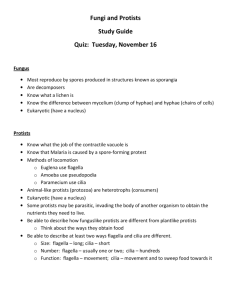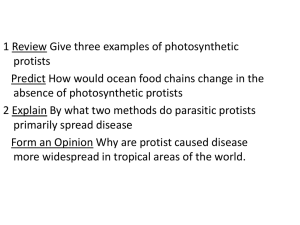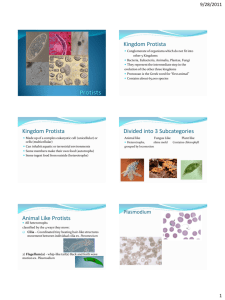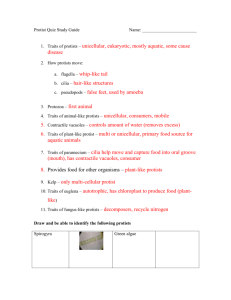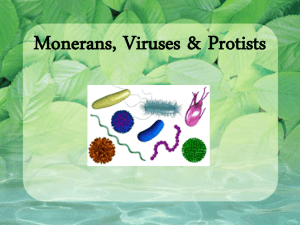Protists
advertisement
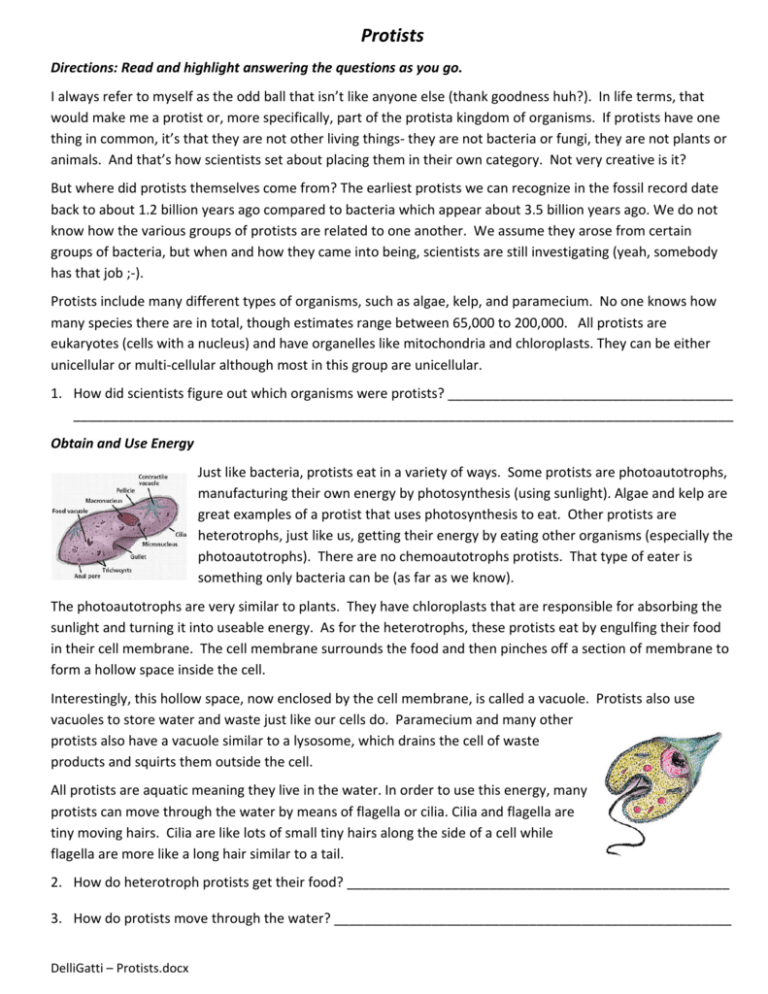
Protists Directions: Read and highlight answering the questions as you go. I always refer to myself as the odd ball that isn’t like anyone else (thank goodness huh?). In life terms, that would make me a protist or, more specifically, part of the protista kingdom of organisms. If protists have one thing in common, it’s that they are not other living things‐ they are not bacteria or fungi, they are not plants or animals. And that’s how scientists set about placing them in their own category. Not very creative is it? But where did protists themselves come from? The earliest protists we can recognize in the fossil record date back to about 1.2 billion years ago compared to bacteria which appear about 3.5 billion years ago. We do not know how the various groups of protists are related to one another. We assume they arose from certain groups of bacteria, but when and how they came into being, scientists are still investigating (yeah, somebody has that job ;‐). Protists include many different types of organisms, such as algae, kelp, and paramecium. No one knows how many species there are in total, though estimates range between 65,000 to 200,000. All protists are eukaryotes (cells with a nucleus) and have organelles like mitochondria and chloroplasts. They can be either unicellular or multi‐cellular although most in this group are unicellular. 1. How did scientists figure out which organisms were protists? ______________________________________ ________________________________________________________________________________________ Obtain and Use Energy Just like bacteria, protists eat in a variety of ways. Some protists are photoautotrophs, manufacturing their own energy by photosynthesis (using sunlight). Algae and kelp are great examples of a protist that uses photosynthesis to eat. Other protists are heterotrophs, just like us, getting their energy by eating other organisms (especially the photoautotrophs). There are no chemoautotrophs protists. That type of eater is something only bacteria can be (as far as we know). The photoautotrophs are very similar to plants. They have chloroplasts that are responsible for absorbing the sunlight and turning it into useable energy. As for the heterotrophs, these protists eat by engulfing their food in their cell membrane. The cell membrane surrounds the food and then pinches off a section of membrane to form a hollow space inside the cell. Interestingly, this hollow space, now enclosed by the cell membrane, is called a vacuole. Protists also use vacuoles to store water and waste just like our cells do. Paramecium and many other protists also have a vacuole similar to a lysosome, which drains the cell of waste products and squirts them outside the cell. All protists are aquatic meaning they live in the water. In order to use this energy, many protists can move through the water by means of flagella or cilia. Cilia and flagella are tiny moving hairs. Cilia are like lots of small tiny hairs along the side of a cell while flagella are more like a long hair similar to a tail. 2. How do heterotroph protists get their food? ___________________________________________________ 3. How do protists move through the water? _____________________________________________________ DelliGatti – Protists.docx Reproduction Protists reproduce asexually through binary fission while a few species are capable of sexual reproduction (2 parents). Animal‐like amoebas and plant‐like Euglena reproduce asexually meaning the only have binary fission. In this case, when the parent cell splits in half, there is an exact chromosome copy in each daughter cell. Paramecium (what we are looking for in pond water) can actually reproduce 2 ways. Normally they reproduce using binary fission. If they get stressed, they will find a partner and reproduce sexually. In this case, it requires 2 parents. The offspring will have parts of both parents in its chromosome similar to how both of your parents have given you equal parts of their chromosomes. 4. How is binary fission different than sexual reproduction? _________________________________________ Grow and Develop All protists are different shapes and Sizes. Most are so tiny that they can’t be seen without a microscope. Protists are categorized into three Groups. They are fungus‐like, animal‐like, and plant‐like. It’s funny how scientists define protists as eukaryotic cells that are not animal, plant or fungus, but then they turn around and compare them back to animals, plants, and fungus. Protists are so small that they do not need any special organs to get rid of wastes (no lysosome even though they have a vacuole that does something similar). They rely on diffusion, the movement of materials from an area of high concentration to an area of low concentration, to move gases and waste materials in and out of the cell. Diffusion only works if you’re really small, so most protists are limited to being small single cells. Another reason protists are small is because the cilia or flagella cannot provide enough energy to move a large cell through the water. So if they are too slow, they get eaten while those that are smaller and faster get to make more protists. 5. Name 2 reasons protists are so tiny __________________________________________________________ _______________________________________________________________________________________ Adaptation and Response Protists have adapted over the many years. For example, the cilia and flagella limit size preventing larger protists from growing not to mention those born without an ability to move get eaten. Another interesting improvement comes from the paramecium. When the paramecium is attacked or feels threatened, it unleashes its defense system ‐ a battery of harpoon‐like spears called trichocysts. Most remain attached to the Paramecium, but some are actually thrown a short distance. Under very high magnification these trichocysts appear as long spears, with sharp pointed ends, much like whalers' harpoons. Often, the paramecium will release everything at its disposal, including undigested food, digested waste and waste water. 6. Name two similarities between bacteria and protists. a. b. 7. Name two differences between bacteria and protists. a. b.



